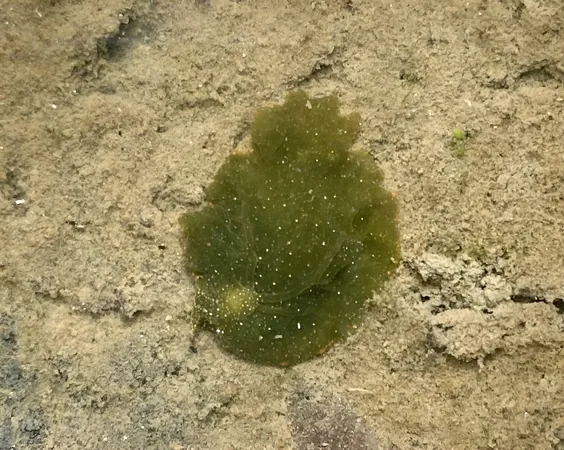
Meet the Incredible Sea Slug That Photosynthesizes Like a Plant!
2025-04-10
Author: Yu
A Hidden Marvel of the Ocean
Often dismissed as simple sea creatures, some sea slugs possess jaw-dropping abilities that defy imagination. Take Elysia chlorotica, for instance—this remarkable little slug doesn’t just stroll along the ocean floor; it harnesses sunlight to produce energy, much like a plant!
Nature’s Master Thief
Dr. Patrick Krug from California State University, Los Angeles, describes this slug as "unique, controversial, and elusive." Elysia chlorotica has developed an extraordinary survival trick: it steals chloroplasts from the algae it consumes and retains them in its own cells, allowing it to photosynthesize for months without eating.
Harnessing the Power of Sunlight
Chloroplasts are the green powerhouses in plants that convert sunlight into energy. Elysia chlorotica’s ability to utilize these organelles makes it a fascinating specimen. Mary E. Rumpho, a prominent biochemist, confirmed a crucial genetic connection in a 2008 study, revealing that the slug expresses genes critical for oxygenic photosynthesis.
Facing Environmental Challenges
Despite its captivating traits, finding Elysia chlorotica is becoming increasingly difficult. Coastal erosion and habitat destruction threaten their marshy homes, while changes in climate and pollution pose additional risks. As the habitat shrinks, so do the opportunities for research on these extraordinary mollusks.
The Mysteries of Survival
One puzzling aspect of Elysia’s biology is how it manages to keep foreign chloroplasts without them triggering an immune response. Normally, the bodies of animals react defensively to intruders. Additionally, the slug seems to handle the toxic byproducts of photosynthesis—free radicals—without suffering damage.
Navigating Research Complexities
Researching Elysia chlorotica is fraught with challenges. Many researchers have pivoted to less elusive species, making it difficult to gather the specimens needed for thorough studies. Furthermore, these slugs have a brief lifespan and require meticulous care to thrive in laboratory conditions.
Genetics: The Next Frontier
Genomic studies are revealing unexpected insights into the slug's DNA, which has over 24,000 protein-coding genes. Scientists are exploring whether Elysia has assimilated additional algal genes, which could shed light on interspecies genetic transfers—a potential game-changer in biotechnology!
Solutions for a Brighter Future
Understanding how Elysia chlorotica adapts to its changing environment could inform ecological restoration initiatives. Strategies might include monitoring water quality or engaging citizen scientists to report sightings, ultimately ensuring these unique creatures are not overlooked.
The Promise of Collaboration
The future looks hopeful for both Elysia chlorotica and the researchers fascinated by its abilities. By fostering collaboration between environmental groups and academic institutions, we can work together to keep this remarkable slug alive for future generations.
Unlocking the Secrets of Solar-Powered Slugs
Experts are excited about the potential breakthroughs that studying this sun-loving sea slug might yield. If scientific teams persist, we may uncover even more mysteries of life, showcasing nature's incredible ability to adapt and innovate.
Every new discovery about Elysia chlorotica could be a testament to nature’s unique solutions, bending the rules of biology as we know it!




 Brasil (PT)
Brasil (PT)
 Canada (EN)
Canada (EN)
 Chile (ES)
Chile (ES)
 Česko (CS)
Česko (CS)
 대한민국 (KO)
대한민국 (KO)
 España (ES)
España (ES)
 France (FR)
France (FR)
 Hong Kong (EN)
Hong Kong (EN)
 Italia (IT)
Italia (IT)
 日本 (JA)
日本 (JA)
 Magyarország (HU)
Magyarország (HU)
 Norge (NO)
Norge (NO)
 Polska (PL)
Polska (PL)
 Schweiz (DE)
Schweiz (DE)
 Singapore (EN)
Singapore (EN)
 Sverige (SV)
Sverige (SV)
 Suomi (FI)
Suomi (FI)
 Türkiye (TR)
Türkiye (TR)
 الإمارات العربية المتحدة (AR)
الإمارات العربية المتحدة (AR)